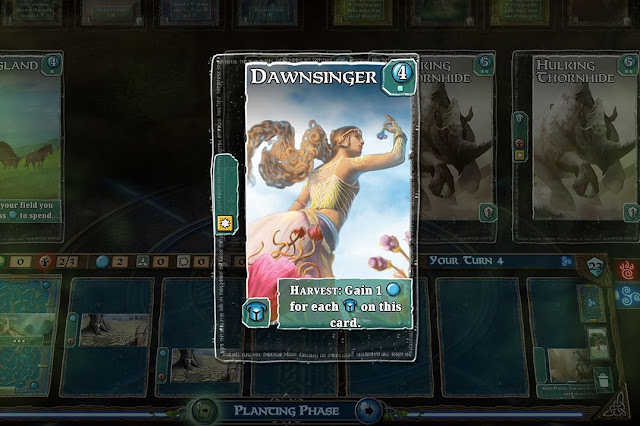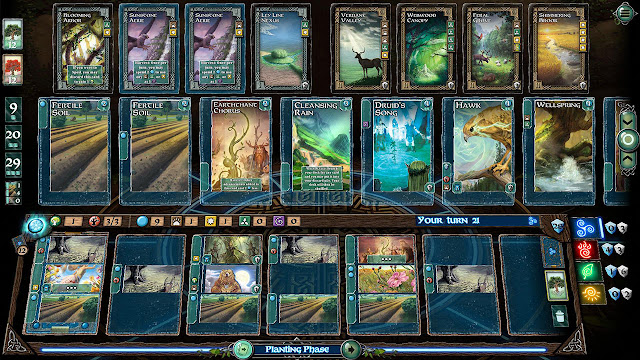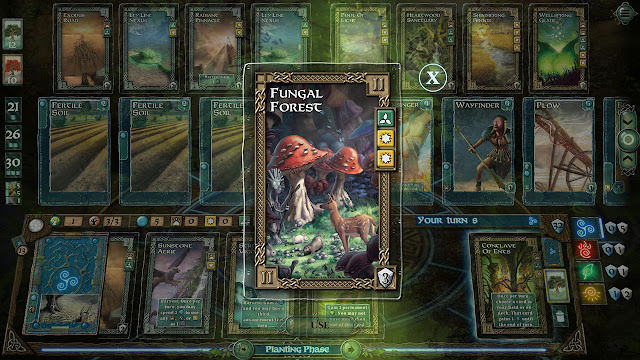Review by Harvard L.
Few things in life are as innately satisfying as seeing a synergistic strategy come together in a card game. The sensation of planning towards a big payoff, or slowly amassing resources which compound in effectiveness once combined with smart decision making, is a potent one indeed. Mystic Vale is this sensation distilled down to a science. It’s a competitive card game designed by tabletop veterans Nomad Games (of Talisman and Fighting Fantasy fame) and has all the bells and whistles of a good deck-builder. This game offers an endless array of possible decks, filled with great combos to build to, an engaging risk-reward system and an abundance of viable strategies to victory. Although the mechanics are relatively non-combative between players compared to some other digital board games, the strategically minded will find lots to love in the Switch edition of this deck building gem.
Mystic Vale began life as a physical card game in 2016, taking inspiration from other deckbuilders such as Dominion and Nomad’s own Smash Up, and picking up a respectable collection of awards for its smart design. The transition to a digital game first on Steam and now on Nintendo Switch affords Mystic Vale some wonderful quality-of-life upgrades, although the adaptation is not perfectly seamless from the tabletop experience.
The setup is simple: each player starts with a deck of mostly blank cards, except for a few pre-made ones. Each card can eventually be augmented with up to three modifiers, which change the resources the card grants when it is drawn from the deck. In the middle of the playing field there are the modifier cards which can be purchased, and form a communal “market” for all the players. Since everyone buys from the same pool, everyone’s current deck and strategy is visible at all times. There are also Vale cards – strong, permanent upgrades which can only be purchased with elemental tokens, which are earned from effective placement of the modifiers.
The game plays out in three phases – in the Planting Phase, players draw cards from their deck and place them face-up until the amount of Decay Tokens among their face-up cards (as well as the revealed top card of their deck) equals to three. Players can then choose to draw as many additional cards as they like, provided that they don’t reach four face-up Decay Tokens – at which point they “spoil”, and concede the rest of their turn. Once the players cards have been laid out, they move to the Harvest phase – in which the symbols on your cards generate Mana and Elemental Tokens, so you can purchase additional cards to add to your deck. The Discard Phase then sees players chucking out their drawn hand and redrawing another set, in preparation for the next turn. The priority goes around the table until each player has had a chance to draw, buy and reshuffle – a quick system which is very reminiscent of Dominion.
Not only is Mystic Vale a deck-building game, but it’s also a card-building game: that is, each card can be augmented with up to three components, so that the possibility space of potential decks is virtually limitless. Whereas other deckbuilders can feel trite after a few rounds as the optimal deck archetypes are “solved”, the sheer amount of permutations for each individual deck and card in Mystic Vale will ensure that no two games are ever the same. The card design is an elegant solution of depth without complexity – the construction of three-pieced cards is immediately understandable and players will always be feeling productive regardless of their experience level. It’s up to players to choose whether they want to make one card in their deck vastly impactful, or whether they want to spread their modifications so they can get value out of every turn.
In the grand matrix of tabletop and board games, Mystic Vale is singularly for the builders and experimenters. Victory is determined through points, which are earned from Vale Cards and certain modifications. There’s a communal pool of “available” victory points in each game, and once these points have been earned out by all players, the game ends and the player with the highest total wins. There’s the always-compelling conflict between “fast” decks which aim to end the game early, versus “slow” decks which aim to make incredible combos overpower everyone else if they’re left to their own devices for too long. The game is non-combat and competitive only in that victory goes to the fastest and most efficient player.
The digital edition of Mystic Vale comes complete with a robust AI in four difficulty levels, which poses a good challenge to even seasoned players. There’s also a functional pass-the-console mode which works well enough – this isn’t a game with any hidden information – but it does leave the other players twiddling their thumbs and looking at nothing when it’s not their turn. Another alternative is online matchmaking, which offers both public and private lobbies.
As mentioned before, in Mystic Vale you won’t be interacting with the other players that much. There are no cards which affect other players’ decks (which thankfully keeps the turn length very short), the only real way players interact is to compete over a common pool of resources, and to end the game early by amassing all the active victory points first. High level play starts to feel like four players aggressively solitaire-ing their way to gain victory points faster than their opponents. There’s still a lot of compelling decision-making and risk-reward analysis, but for board game players who live to actually play a game with the other players, there’s not a single mechanic here that will whet that chaotic appetite.
The sensation of interaction further gets lost out in the transition from tabletop to digital. On tabletop, there’s lots of things for players to do while waiting for your opponents to make their decisions – they can move around their cards, examine the state of the board, and shuffle their deck as a fidget. This sounds trivial but is a palpable change once you’re passing around a single Switch in a group of four – it just feels like there’s something missing. Players also don’t have much access to information on opponents’ sides of the field: the game does show all players what a player buys, as they buy it, but you aren’t able to see your opponents’ deck constantly, and so you’ll need to rely on memory to keep track of what each player’s archetype is. On tabletop, however, all this information would be immediately available. That being said, the three-component cards are enormous in Mystic Vale’s boxed edition and are very finicky to shuffle and interact with; setup and put away takes forever. It’s a tradeoff depending on what your friends prefer.
Mystic Vale is not without its flaws, but for fans of open and complex card games, it also offers a tantalising amount of depth. Being able to piece together a powerful deck and then watch it have a stellar turn is immensely satisfying, whether if it’s your first or one hundredth game. The addition of expansion packs and online play to the Switch version further amps up the game’s value and replay value. It’s a particular flavour of strategy; one which caters towards the deep thinkers and mad scientists, who aren’t so much competitive as they are inventive. If that sounds like your friends though, Mystic Vale on the Switch would be a great addition to a cerebral games night.
– Harvard L.
Contributor
Review code provided by publisher.











